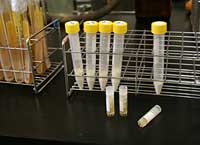|
|
|||||||
|
|
|||||||
|
|||||||
| | Web Japan >> | Trends in Japan >> | Business & Economy >> | The Final Frontier | |
|
THE FINAL FRONTIER Venture Firms Join the Space Business (November 8, 2005) The business of space travel and technology has long been in the hands of a small number of large corporations. Yet in recent years, as advances in technology have made satellites easier to launch and space missions more frequent, a growing number of small and medium-sized companies have entered the industry. In Japan, a host of such companies, many based in rural areas, are winning space-related contracts or planning their own space adventures. Commercial Countdown Hokkaido New Satellite Technology, as its name makes clear, is a Hokkaido-based venture company actively involved in the satellite business. The company is planning to launch the satellite Taiki (meaning "big tree") in fiscal 2007 (April 2007 to March 2008). The craft measures 50 x 50 x 50 centimeters and will pass over Japan twice a day. Its role will be to assist in the study of crops by transmitting data collected by a hyperspectral camera. The project, an example of an alliance between agriculture and academia, is being carried out in cooperation with the Hokkaido Institute of Technology. Surveying Space Junk The tethered satellite will have a couple of unusual missions. One of its jobs will be to survey the Earth's atmosphere. It will make its observations by extending a long cord about 50 kilometers from the its orbital path toward the upper atmosphere. Its other role involves the human-made debris, commonly called "space junk," that is floating around in space. The craft's operators will try to have the cable make physical contact with pieces of debris in an effort to evaluate and revise the current model of the space debris environment. This would be the first satellite of its kind to be launched into a fully fledged orbit. Another unique space project is expected to result in a new type of Japanese sake called Tosa Space Sake. Taking part are 19 brewers of Japanese sake in Kochi Prefecture, the prefectural government, and universities. Several types of freeze-dried yeast used in sake brewing were launched into space aboard a Russian Soyuz rocket on October 1, 2005, from the Russian space center in Baikonur. The yeast, along with rice from Kochi, is to be used to brew the sake. The premise behind the project is that the yeast will undergo changes during its 10 days aboard the spaceship, although no one is certain what kind of changes will take place. Sake made using the yeast after it returns to Earth will be sold throughout Japan from April 2006, and there are plans to eventually market it overseas. There are high hopes that the space sake will find favor among consumers keen to get a taste of the extraterrestrial. The recent entry of small and mid-sized firms into the space race illustrates the innovative thinking and technology that have enabled many small Japanese manufacturers to thrive. Copyright (c) 2005 Web Japan. Edited by Japan Echo Inc. based on domestic Japanese news sources. Articles presented here are offered for reference purposes and do not necessarily represent the policy or views of the Japanese Government. |
H-IIA READY FOR SPACE (August 20, 2001) JAPAN'S SPACE HOPES FOR THE TWENTY-FIRST CENTURY (March 1, 2001) |
|
|



